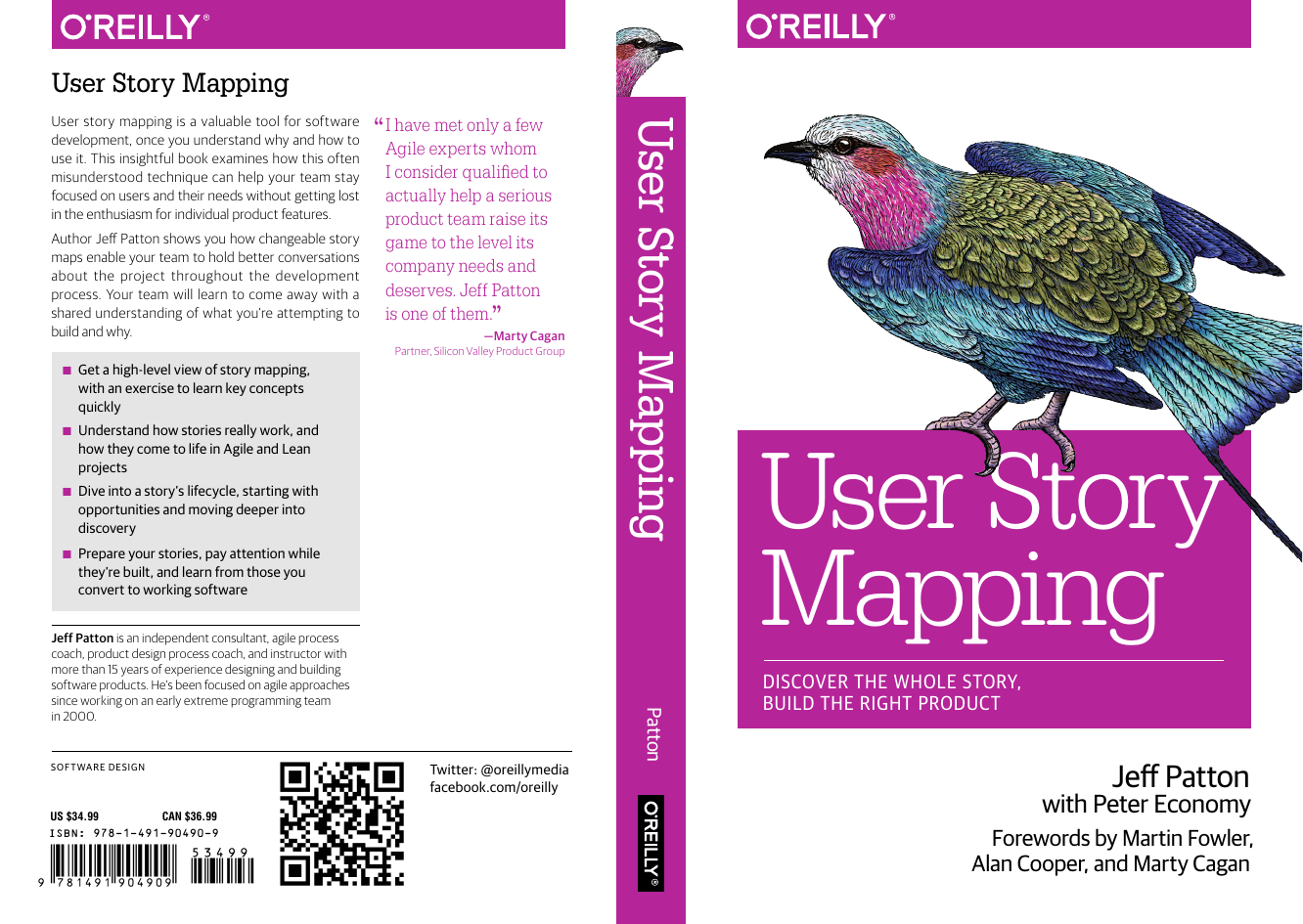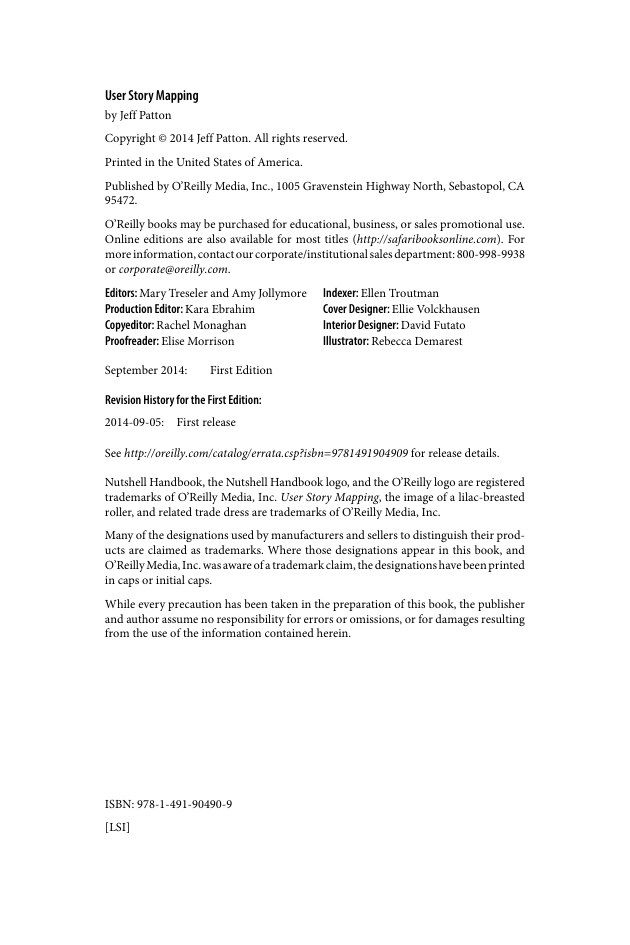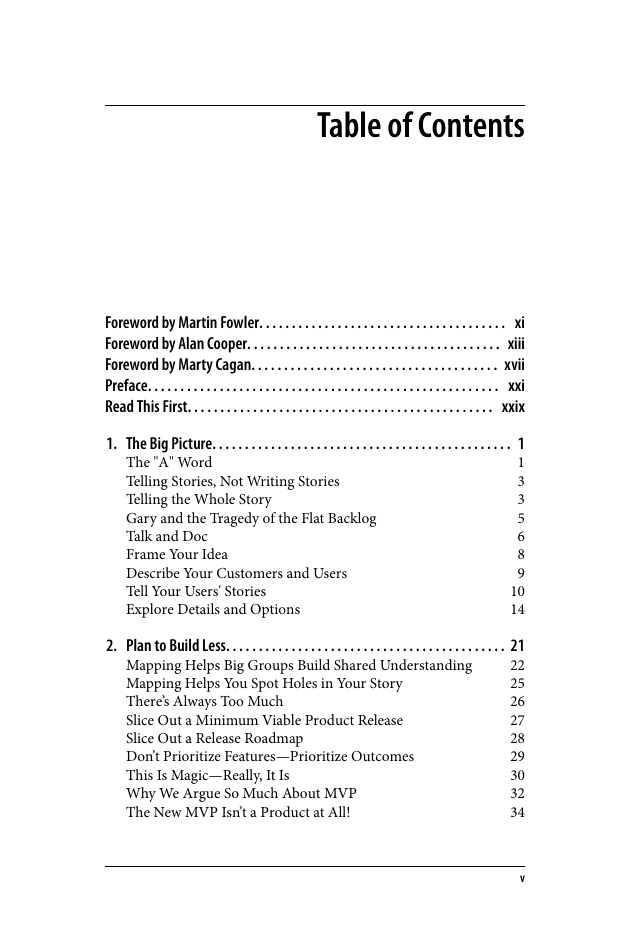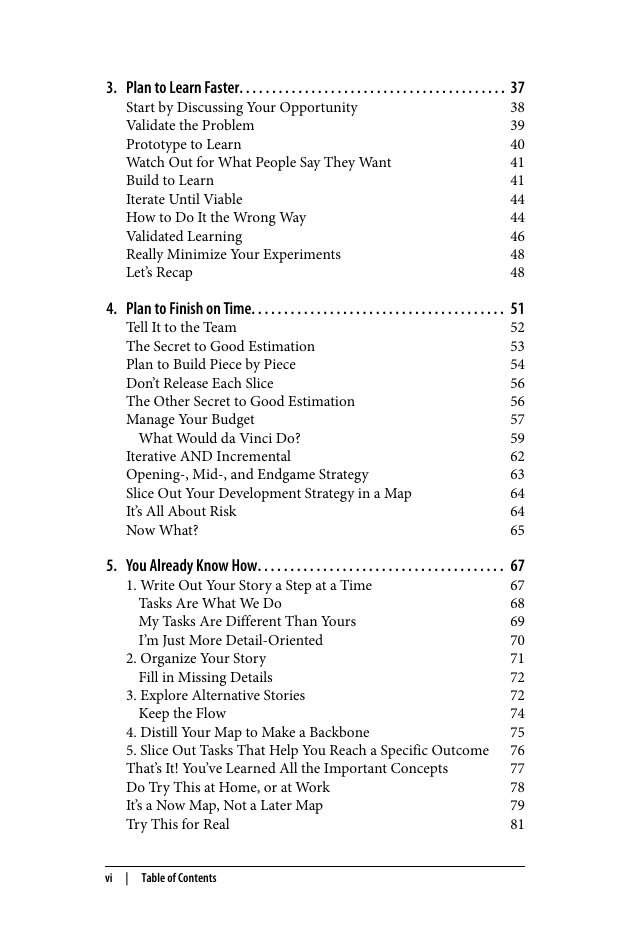Copyright
Table of Contents
Foreword by Martin Fowler
Foreword by Alan Cooper
Foreword by Marty Cagan
Preface
Why Me?
This Book Is for You If You’re Struggling with Stories
Who Should Read This Book?
A Few Conventions Used in This Book
The Headings Inside Each Chapter Guide You Through the Subject
How This Book Is Organized
Story Mapping from 10,000 Feet
Grokking User Stories
Better Backlogs
Better Building
Safari® Books Online
How to Contact Us
Read This First
The Telephone Game
Building Shared Understanding Is Disruptively Simple
Stop Trying to Write Perfect Documents
Good Documents Are Like Vacation Photos
Document to Help Remember
Talking About the Right Thing
Now and Later
Software Isn’t the Point
OK, It’s Not Just About People
Build Less
More on the Dreaded "R" Word
That’s All There Is to It
Chapter 1. The Big Picture
The "A" Word
Telling Stories, Not Writing Stories
Telling the Whole Story
Gary and the Tragedy of the Flat Backlog
Talk and Doc
Frame Your Idea
Describe Your Customers and Users
Tell Your Users' Stories
Explore Details and Options
Chapter 2. Plan to Build Less
Mapping Helps Big Groups Build Shared Understanding
Mapping Helps You Spot Holes in Your Story
There’s Always Too Much
Slice Out a Minimum Viable Product Release
Slice Out a Release Roadmap
Don’t Prioritize Features—Prioritize Outcomes
This Is Magic—Really, It Is
Why We Argue So Much About MVP
The New MVP Isn’t a Product at All!
Chapter 3. Plan to Learn Faster
Start by Discussing Your Opportunity
Validate the Problem
Prototype to Learn
Watch Out for What People Say They Want
Build to Learn
Iterate Until Viable
How to Do It the Wrong Way
Validated Learning
Really Minimize Your Experiments
Let’s Recap
Chapter 4. Plan to Finish on Time
Tell It to the Team
The Secret to Good Estimation
Plan to Build Piece by Piece
Don’t Release Each Slice
The Other Secret to Good Estimation
Manage Your Budget
What Would da Vinci Do?
Iterative AND Incremental
Opening-, Mid-, and Endgame Strategy
Slice Out Your Development Strategy in a Map
It’s All About Risk
Now What?
Chapter 5. You Already Know How
1. Write Out Your Story a Step at a Time
Tasks Are What We Do
My Tasks Are Different Than Yours
I’m Just More Detail-Oriented
2. Organize Your Story
Fill in Missing Details
3. Explore Alternative Stories
Keep the Flow
4. Distill Your Map to Make a Backbone
5. Slice Out Tasks That Help You Reach a Specific Outcome
That’s It! You’ve Learned All the Important Concepts
Do Try This at Home, or at Work
It’s a Now Map, Not a Later Map
Try This for Real
With Software It’s Harder
The Map Is Just the Beginning
Chapter 6. The Real Story About Stories
Kent’s Disruptively Simple Idea
Simple Isn’t Easy
Ron Jeffries and the 3 Cs
1. Card
2. Conversation
3. Confirmation
Words and Pictures
That’s It
Chapter 7. Telling Better Stories
Connextra’s Cool Template
Template Zombies and the Snowplow
A Checklist of What to Really Talk About
Create Vacation Photos
It’s a Lot to Worry About
Chapter 8. It’s Not All on the Card
Different People, Different Conversations
We’re Gonna Need a Bigger Card
Radiators and Ice Boxes
That’s Not What That Tool Is For
Building Shared Understanding
Remembering
Tracking
Chapter 9. The Card Is Just the Beginning
Construct with a Clear Picture in Your Head
Build an Oral Tradition of Storytelling
Inspect the Results of Your Work
It’s Not for You
Build to Learn
It’s Not Always Software
Plan to Learn, and Learn to Plan
Chapter 10. Bake Stories Like Cake
Create a Recipe
Breaking Down a Big Cake
Chapter 11. Rock Breaking
Size Always Matters
Stories Are Like Rocks
Epics Are Big Rocks Sometimes Used to Hit People
Themes Organize Groups of Stories
Forget Those Terms and Focus on Storytelling
Start with Opportunities
Discover a Minimum Viable Solution
Dive into the Details of Each Story During Delivery
Keep Talking as You Build
Evaluate Each Piece
Evaluate with Users and Customers
Evaluate with Business Stakeholders
Release and Keep Evaluating
Chapter 12. Rock Breakers
Valuable-Usable-Feasible
A Discovery Team Needs Lots of Others to Succeed
The Three Amigos
Product Owner as Producer
This Is Complicated
Chapter 13. Start with Opportunities
Have Conversations About Opportunities
Dig Deeper, Trash It, or Think About It
Opportunity Shouldn’t Be a Euphemism
Story Mapping and Opportunities
Be Picky
Chapter 14. Using Discovery to Build Shared Understanding
Discovery Isn’t About Building Software
Four Essential Steps to Discovery
1. Frame the Idea
2. Understand Customers and Users
3. Envision Your Solution
4. Minimize and Plan
Discovery Activities, Discussions, and Artifacts
Discovery Is for Building Shared Understanding
Chapter 15. Using Discovery for Validated Learning
We’re Wrong Most of the Time
The Bad Old Days
Empathize, Focus, Ideate, Prototype, Test
How to Mess Up a Good Thing
Short Validated Learning Loops
How Lean Startup Thinking Changes Product Design
Start by Guessing
Name Your Risky Assumptions
Design and Build a Small Test
Measure by Running Your Test with Customers and Users
Rethink Your Solution and Your Assumptions
Stories and Story Maps?
Chapter 16. Refine, Define, and Build
Cards, Conversation, More Cards, More Conversations…
Cutting and Polishing
Workshopping Stories
Sprint or Iteration Planning?
Crowds Don’t Collaborate
Split and Thin
Use Your Story Map During Delivery
Use a Map to Visualize Progress
Use Simple Maps During Story Workshops
Chapter 17. Stories Are Actually Like Asteroids
Reassembling Broken Rocks
Don’t Overdo the Mapping
Don’t Sweat the Small Stuff
Chapter 18. Learn from Everything You Build
Review as a Team
Review with Others in Your Organization
Enough
Learn from Users
Learn from Release to Users
Outcomes on a Schedule
Use a Map to Evaluate Release Readiness
The End, or Is It?
Acknowledgments
References
Index
About the Author
















 2023年江西萍乡中考道德与法治真题及答案.doc
2023年江西萍乡中考道德与法治真题及答案.doc 2012年重庆南川中考生物真题及答案.doc
2012年重庆南川中考生物真题及答案.doc 2013年江西师范大学地理学综合及文艺理论基础考研真题.doc
2013年江西师范大学地理学综合及文艺理论基础考研真题.doc 2020年四川甘孜小升初语文真题及答案I卷.doc
2020年四川甘孜小升初语文真题及答案I卷.doc 2020年注册岩土工程师专业基础考试真题及答案.doc
2020年注册岩土工程师专业基础考试真题及答案.doc 2023-2024学年福建省厦门市九年级上学期数学月考试题及答案.doc
2023-2024学年福建省厦门市九年级上学期数学月考试题及答案.doc 2021-2022学年辽宁省沈阳市大东区九年级上学期语文期末试题及答案.doc
2021-2022学年辽宁省沈阳市大东区九年级上学期语文期末试题及答案.doc 2022-2023学年北京东城区初三第一学期物理期末试卷及答案.doc
2022-2023学年北京东城区初三第一学期物理期末试卷及答案.doc 2018上半年江西教师资格初中地理学科知识与教学能力真题及答案.doc
2018上半年江西教师资格初中地理学科知识与教学能力真题及答案.doc 2012年河北国家公务员申论考试真题及答案-省级.doc
2012年河北国家公务员申论考试真题及答案-省级.doc 2020-2021学年江苏省扬州市江都区邵樊片九年级上学期数学第一次质量检测试题及答案.doc
2020-2021学年江苏省扬州市江都区邵樊片九年级上学期数学第一次质量检测试题及答案.doc 2022下半年黑龙江教师资格证中学综合素质真题及答案.doc
2022下半年黑龙江教师资格证中学综合素质真题及答案.doc